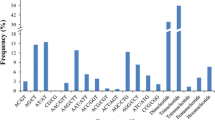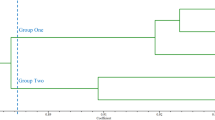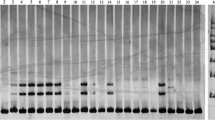Abstract
Key message
We developed and identified a new set of polymorphic EST-SSR markers in Sorbus pohuashanensis (Hance) Hedl. and generated an optimal sampling strategy.
Abstract
Sorbus pohuashanensis (Hance) Hedl. is indigenous to northern China and prized for its graceful appearance and seasonal variations in foliage color. However, only a few molecular biology studies have been conducted on this species. Therefore, its development and increased utilization are limited. The objective of the present study was to develop expressed sequence tag-simple sequence repeat (EST-SSR) markers based on the transcriptome data of this species. A total of 167 primer pairs were designed and 24 were randomly selected from the 55 initially screened for validation. Their polymorphism was assessed using samples of the Mount Kunyu in Shandong Province (SDKYS) population. Fifteen EST-SSR markers were identified as polymorphic, with a mean number of alleles (Na) and a polymorphism information content (PIC) of 8.2 and 0.6907, respectively. Thirty EST-SSRs (including another 15 EST-SSRs being previously developed) derived from S. pohuashanensis had high transferability (90%) to another 14 Sorbus species, and there were nine EST-SSRs applicable to Sorbus species tested. These Sorbus species were divided into two main clusters by an unweighted pair-group method with the arithmetic mean (UPGMA) clustering tree based on the nine EST-SSRs and was validated by principal coordinate analysis (PCoA). The sampling strategy showed that 25 randomly selected individuals from a population of S. pohuashanensis could represent 95% of its genetic diversity level. In all, these findings would provide a powerful theoretical basis for future studies on the genetic diversity and germplasm resources of S. pohuashanensis and its related species.




Similar content being viewed by others
References
Bai C, Wen M, Zhang L, Li G (2013) Genetic diversity and sampling strategy of Scutellaria baicalensis germplasm resources based on ISSR. Genet Resour Crop Evol 60:1673–1685. https://doi.org/10.1007/s10722-012-9949-9
Barboza K, Beretta V, Kozub PC, Salinas C, Morgenfeld MM, Galmarini CR, Cavagnaro PF (2018) Microsatellite analysis and marker development in garlic: distribution in EST sequence, genetic diversity analysis, and marker transferability across Alliaceae. Mol Genet Genomics 293:1091–1106. https://doi.org/10.1007/s00438-018-1442-5
Bian L, Yang L, Wang J-a, Shen H-l (2013) Effects of KNO3 pretreatment and temperature on seed germination of Sorbus pohuashanensis. J For Res 24:309–316. https://doi.org/10.1007/s11676-013-0354-9
Botstein D, White RL, Skolnick M, Davis RW (1980) Construction of a genetic linkage map in man using restriction fragment length polymorphisms. Am J Hum Genet 32:314–331
Campbell CS, Wojciechowski MF, Baldwin BG, Alice LA, Donoghue MJ (1997) Persistent nuclear ribosomal DNA sequence polymorphism in the Amelanchier agamic complex (Rosaceae). Mol Biol Evol 14:81–90. https://doi.org/10.1093/oxfordjournals.molbev.a025705
Cavagnaro PF et al (2011) Microsatellite isolation and marker development in carrot—genomic distribution, linkage mapping, genetic diversity analysis and marker transferability across Apiaceae. BMC Genomics 12:386. https://doi.org/10.1186/1471-2164-12-386
Cheng Y, Yang Y, Wang Z, Qi B, Yin Y, Li H (2015) Development and characterization of EST-SSR markers in Taxodium ‘zhongshansa’. Plant Mol Biol Rep 33:1804–1814. https://doi.org/10.1007/s11105-015-0875-9
Colburn BC, Mehlenbacher SA, Sathuvalli VR (2017) Development and mapping of microsatellite markers from transcriptome sequences of European hazelnut (Corylus avellana L) and use for germplasm characterization. Mol Breed 37:16. https://doi.org/10.1007/s11032-016-0616-2
da Silva RA et al (2017) Genome size, cytogenetic data and transferability of EST-SSRs markers in wild and cultivated species of the genus Theobroma L. (Byttnerioideae, Malvaceae). PLoS One 12:e0170799. https://doi.org/10.1371/journal.pone.0170799
Decaisne MJ (1874) Mémoirs sur le famille des Pomacées. Nouv Arch Mus Hist Nat 10:113–192
Dong M, Wang Z, He Q, Zhao J, Fan Z, Zhang J (2018) Development of EST-SSR markers in Larix principis-rupprechtii Mayr and evaluation of their polymorphism and cross-species amplification. Trees 32:1559–1571. https://doi.org/10.1007/s00468-018-1733-9
Du Q, Wang B, Wei Z, Zhang D, Li B (2012) Genetic diversity and population structure of Chinese White poplar (Populus tomentosa) revealed by SSR markers. J Hered 103:853–862. https://doi.org/10.1093/jhered/ess061
Duran C, Singhania R, Raman H, Batley J, Edwards D (2013) Predicting polymorphic EST-SSRs in silico. Mol Ecol Resour 13(3):538–545. https://doi.org/10.1111/1755-0998.12078
Ellis JR, Burke JM (2007) EST-SSRs as a resource for population genetic analyses. Heredity 99:125–132. https://doi.org/10.1038/sj.hdy.6801001
Feng J, Zhang C, Zhang C, Sun R (2011) Identification of Poplar varieties by SSR markers using capillary electrophoresis with fluorescence detection. Scientia Silvae Sinicae 47:167–174
Hall BG (2013) Building phylogenetic trees from molecular data with MEGA. Mol Biol Evol 30:1229–1235. https://doi.org/10.1093/molbev/mst012
Huang P, Cui P, Zheng Y, Zhang C, Yu X (2012) SSR-based molecular identification and analysis of genetic relationships among Rose varieties. Scientia Silvae Sinicae 48:55–62
Jia X, Deng Y, Sun X, Liang L, Su J (2016) De novo assembly of the transcriptome of Neottopteris nidus using Illumina paired-end sequencing and development of EST-SSR markers. Mol Breed 36:94. https://doi.org/10.1007/s11032-016-0519-2
Jin Y, Lu B (2003) Sampling strategy for genetic diversity. Biodivers Sci 11:155–161
Kalia RK, Rai MK, Kalia S, Singh R, Dhawan AK (2010) Microsatellite markers: an overview of the recent progress in plants. Euphytica 177:309–334. https://doi.org/10.1007/s10681-010-0286-9
Kullan ARK, Kulkarni AV, Kumar RS, Rajkumar R (2016) Development of microsatellite markers and their use in genetic diversity and population structure analysis in Casuarina. Tree Genet Genomes 12:49. https://doi.org/10.1007/s11295-016-1009-8
Li L, Chen X (2018) Effect of saline—alkali stress on Sorbus pohuashanensis. J Jilin For Sci Technol 47:10–12
Li A, Wang K, Ge S (2000) Genetic diversity within and among populations of Viola tenuicornis with reference to sampling strategies. Acta Botanica Sinica 42:1069–1074
Li H, Cui L, Wang Z (2008) Sorbus pohuashanensis cultivation technique. Land Green (4):57
Li X et al (2013) Construction of peach genotype database with fluorescent-labeled SSR markers. J Fruit Sci 30:924–932
Li Y, Yang X, Zhang J, Huang S, Xiong X (2014) Studies on SSR molecular markers based on transcriptome of Taxus chinensis var mairei. Acta Horticulturae Sinica 41:735–745
Li A, Wang X, Hai L, Hong G, Li Z, Wang P (2017a) Phenotypic diversity and utilization of natural population of Sorbus Pohuashanensis in Inner Mongolia. J Inner Mong For Sci Technol 43:5–9
Li ZZ, Tian H, Zhang JJ (2017b) Characterization and development of EST-derived SSR markers in Sinowilsonia henryi (Hamamelidaceae). Appl Plant Sci. https://doi.org/10.3732/apps.1700080
Linnaeus C (1753) Species plantarum. In: Laurentill Salvii, vol 1, Holmiae, pp 475–480
Liu D, Shen H, Yang Y, Zhang J (2003) Genetic diversity of rare and endangered plant Sorbus amabilis Chinese. J Appl Ecol 14:2141–2144
Liu C et al (2017) De novo transcriptomic analysis and development of EST-SSRs for Sorbus pohuashanensis (Hance) Hedl. PLoS One 12:e0179219. https://doi.org/10.1371/journal.pone.0179219
Liu C, Zhang Z, Guan X, Pei X, Zheng J (2019a) Cloning and expression analysis of heat shock protein 70 gene in Sorbus pohuashanensis. Mol Plant Breed 17:6276–6286
Liu F et al (2019b) Genetic diversity of the endangered dalbergia odorifera revealed by SSR markers. Forests. https://doi.org/10.3390/f10030225
Lu LD, Spongberg SA (2003) Flora of China, vol 9. Science Press Missouri Botanical Garden Press, Beijing
Mariotti R et al (2016) Development, evaluation, and validation of new EST-SSR markers in olive (Olea europaea L.). Tree Genet Genomes 12:120. https://doi.org/10.1007/s11295-016-1077-9
Marshall DR (1989) Genetics and conservation of rare plants. In: Brown AHD, Clegg MT, Kahler AL, Weir BS (eds) Crop genetic resources: current and emerging. Oxford University Press, New York, pp 367–388
Najafzadeh R, Arzani K, Bouzari N, Saei A (2016) Genetic variation and identification of promising Sour cherries inferred from microsatellite markers. Гeнeтикa 52:74–83. https://doi.org/10.7868/s0016675815110119
Nelson-Jones B, Briggs D, Smith G (2002) The origin of intermediate species of the genus Sorbus. Theor Appl Genet 105:953–963. https://doi.org/10.1007/s00122-002-0957-6
Northwest Institute of Botany Caos (1974) In: Flora Tsinlingensis, vol 1. Science Press, Beijing, p 608
Ohyama A et al (2017) Bayesian QTL mapping using genome-wide SSR markers and segregating population derived from a cross of two commercial F1 hybrids of tomato. Theor Appl Genet 130:1601–1616. https://doi.org/10.1007/s00122-017-2913-5
O’Neill EM et al (2013) Parallel tagged amplicon sequencing reveals major lineages and phylogenetic structure in the North American tiger salamander (Ambystoma tigrinum) species complex. Mol Ecol 22:111–129. https://doi.org/10.1111/mec.12049
Pandey G, Misra G, Kumari K, Gupta S, Kumar Parida S, Chattopadhyay D, Prasad M (2013) Genome-wide development and use of microsatellite markers for large-scale genotyping applications in Foxtail Millet [Setaria italica (L.)]. DNA Res 20:197–207. https://doi.org/10.1093/dnares/dst002
Peakall R, Smouse PE (2012) GenAlEx 6.5: genetic analysis in Excel. Population genetic software for teaching and research—an update. Bioinformatics (Oxford, England) 28:2537–2539. https://doi.org/10.1093/bioinformatics/bts460
Phipps JB, Robertson KR, Smith PG, Rohrer JR (1990) A checklist of the subfamily Maloideae (Rosaceae). Can J Bot 68:2209–2269
Pyne RM, Honig JA, Vaiciunas J, Wyenandt CA, Simon JE (2018) Population structure, genetic diversity and downy mildew resistance among Ocimum species germplasm. BMC Plant Biol 18:69. https://doi.org/10.1186/s12870-018-1284-7
Roemer MJ (1847) Familiarum naturalium regni vegetabilis synopses monographicae. III. Rosiflorae. Amygdalacearum et Pomacearum. In. Landes-Industrie-Comptoir, Weimar
Sjögren-Gulve P, Wyoni P-I (1994) Conservation genetics and detection of rare alleles in finite populations. Conserv Biol 8:267–270. https://doi.org/10.1046/j.1523-1739.1994.08010267.x
Slate J, Marshall T, Pemberton J (2000) A retrospective assessment of the accuracy of the paternity inference program cervus. Mol Ecol 9:801–808
Sun R, Lin F, Huang P, Zheng Y (2016) Moderate genetic diversity and genetic differentiation in the relict tree Liquidambar formosana Hance revealed by genic simple sequence repeat markers. Front Plant Sci 7:1411. https://doi.org/10.3389/fpls.2016.01411
Tautz D (1989) Hypervariability of simple sequences as a general source of polymorphic DNA markers. Nucleic Acid Res 17:6463–6471
The CAS Committee of the Flora of China (1974) Flora of China, vol 36. Science Press, Beijing
Ukoskit K, Posudsavang G, Pongsiripat N, Chatwachirawong P, Klomsa-Ard P, Poomipant P, Tragoonrung S (2018) Detection and validation of EST-SSR markers associated with sugar-related traits in sugarcane using linkage and association mapping. Genomics. https://doi.org/10.1016/j.ygeno.2018.03.019
Van Oosterhout C, Hutchinson WF, Wills D, Shipley P (2004) MICRO-CHECKER: Software for identifying and correcting genotyping errors in microsatellite data. Mol Ecol Notes 4:535–538. https://doi.org/10.1111/j.1471-8286.2004.00684.x
Wang G, Zhang M (2011) A molecular phylogeny of Sorbus (Rosaceae) based on ITS sequence. Acta Horticulturae Sinica 38:2387–2394
Wang X et al (2018) Development of EST-SSR markers and their application in an analysis of the genetic diversity of the endangered species Magnolia sinostellata. Mol Genet Genomics. https://doi.org/10.1007/s00438-018-1493-7
Wen M, Wang H, Xia Z, Zou M, Lu C, Wang W (2010) Developmenrt of EST-SSR and genomic-SSR markers to assess genetic diversity in Jatropha Curcas L. BMC Res Notes 3:42. https://doi.org/10.1186/1756-0500-3-42
Wen Y, Uchiyama K, Han W, Ueno S, Xie W, Xu G, Tsumura Y (2013) Null alleles in microsatellite markers. Biodivers Sci 21:117–126
Wen Y, Wen Y, Zhou H, Xu G (2015) SSR mining and development of EST-SSR markers for Cunninghamia lanceolata based on transcriptome sequences. Scientia Silvae Sinicae 51:40–49
Wu J, Cai C, Cheng F, Cui H, Zhou H (2014) Characterisation and development of EST-SSR markers in tree peony using transcriptome sequences. Mol Breed 34:1853–1866. https://doi.org/10.1007/s11032-014-0144-x
Wu J, Cheng F, Cai C, Zhong Y, Jie X (2017) Association mapping for floral traits in cultivated Paeonia rockii based on SSR markers. Mol Genet Genomics 292:187–200. https://doi.org/10.1007/s00438-016-1266-0
Yan Z et al (2017) Cross-species transferability of EST-SSR markers developed from the transcriptome of Melilotus and their application to population genetics research. Sci Rep 7:17959. https://doi.org/10.1038/s41598-017-18049-8
Yang J et al (2013) Genetic diversity and structure of wintersweet (Chimonanthus praecox) revealed by EST-SSR markers. Sci Hortic 150:1–10. https://doi.org/10.1016/j.scienta.2012.11.004
Yang S, Zhong Q, Tian J, Wang L, Zhao M, Li L, Sun X (2018) Characterization and development of EST-SSR markers to study the genetic diversity and populations analysis of Jerusalem artichoke (Helianthus tuberosus L.). Genes Genomics. https://doi.org/10.1007/s13258-018-0708-y
Yeh FC, Rongcai Y, Boyle T, Ye Z, Xiyan JM (1999) POPGENE, the user-friendly shareware for population genetic analysis. Molecular Biology and Biotechnology Centre, University of Alberta, Canada, Edmonton, AB
You M et al (2018) Effect of ecological isolated island of Fan Jingshan in Guizhou based on the comparative analysis of Spermatophyte Flora. Mol Plant Breed 16:8185–8198
Zhang G, Junbao L, Hu Y, Chen H, Liu B (2011) Sorbus pohuashanensis seed collection and processing and seedling artificial cultivation technology. Sci Technol West China 10:58+50
Zhang M, Fan L, Liu Q, Song Y, Wei S, Zhang S, Wu J (2013) A novel set of EST-derived SSR markers for Pear and cross-species transferability in Rosaceae. Plant Mol Biol Rep 32:290–302. https://doi.org/10.1007/s11105-013-0638-4
Zhang Y, Zhang X, Wang YH, Shen SK (2017) De novo assembly of transcriptome and development of novel EST-SSR markers in Rhododendron rex levl. through Illumina sequencing. Front Plant Sci 8:1664. https://doi.org/10.3389/fpls.2017.01664
Zheng W (1985) SylvaSinica. ChinaMForestry Publishing House, Beijing
Zheng D, Zhang M (2007) A cladistic and phenetic analysis of the infrageneric relationships of Sorbus s. l. (Maloideae, Rosaceae) based on the morphological characters. Acta Horticulturae Sinica 34:723–728
Zheng J, Zheng Y, Wu C, Zhang C, Zong Y, Li B, Zhu Y (2007) Geographical distribution and patterns of natural regeneration of Sorbus pohuashanensis. Scientia Silvae Sinicae 43:86–93
Zheng Y, Zheng J, Zhang C (2008) Sorbus pohuashanensis, a potential ornamental species for gardening and landscaping. J Chin Urban For 6:74–76
Zheng J, Zheng Y, Wu C (2009a) Propagation of Sorbus pohuashanensis by softwood cuttings. For Res 22:91–97
Zheng J, Zheng Y, Zong Y, Li B (2009b) Phenotypic diversity of fruits and seeds in natural populations of Sorbus pohuashanensis. J Plant Genet Resour 10:385–391
Zhou T et al (2016) Transcriptome sequencing and development of genic SSR markers of an endangered Chinese endemic genus Dipteronia Oliver (Aceraceae). Molecules 21:166. https://doi.org/10.3390/molecules21030166
Acknowledgements
This work was supported by the National Natural Fund Project (No. 31770369) and Beijing Municipal Education Commission General Project (No. KM201810020014). The authors thank the National Forest Genetic Resources Platform (NFGRP) for providing the S. pohuashanensis resources and Editage English Editing company (https://app.editage.cn) for providing language assistance during the preparation of this manuscript.
Author information
Authors and Affiliations
Corresponding author
Ethics declarations
Conflict of interest
The authors declare that they do not have any conflicts of interest.
Additional information
Communicated by Peterson.
Publisher's Note
Springer Nature remains neutral with regard to jurisdictional claims in published maps and institutional affiliations.
Electronic supplementary material
Below is the link to the electronic supplementary material.
468_2019_1928_MOESM1_ESM.rar
Table S1: The repeat motif types and the primer sequences of the 167 EST-SSRs for Sorbus pohuashanensis. Table S2: Transferability of the 30 EST-SSR markers developed from Sorbus pohuashanensisis to other Sorbus species. Table S3: Polymorphism analysis of 30 EST-SSRs in Sorbus amabilis. Table S4: Nei’s Original Measures of Genetic Identity and Genetic distance among 15 Sorbus species. Table S5: Polymorphism analysis of the 30 EST-SSR markers from Sorbus pohuashanensis in HBBS population. Table S6: The mean values and percentage from the 14 groups of subsamples for 30 loci in Sorbus pohuashanensis from HBBS population. Table S7: The gene frequency of each locus in Sorbus pohuashanensis from the HBBS population. Table S8: The mean values and percentage from the 14 groups of subsamples without null allele. Table S9: The mean values and percentage from the 14 groups of subsamples without the loci significantly deviating from Hardy–Weinberg equilibrium. (RAR 133 kb)
Rights and permissions
About this article
Cite this article
Wu, Y., He, R., Lu, Y. et al. Development and evaluation of EST-SSR markers in Sorbus pohuashanensis (Hance) Hedl. and their application to other Sorbus species. Trees 34, 455–467 (2020). https://doi.org/10.1007/s00468-019-01928-0
Received:
Accepted:
Published:
Issue Date:
DOI: https://doi.org/10.1007/s00468-019-01928-0




